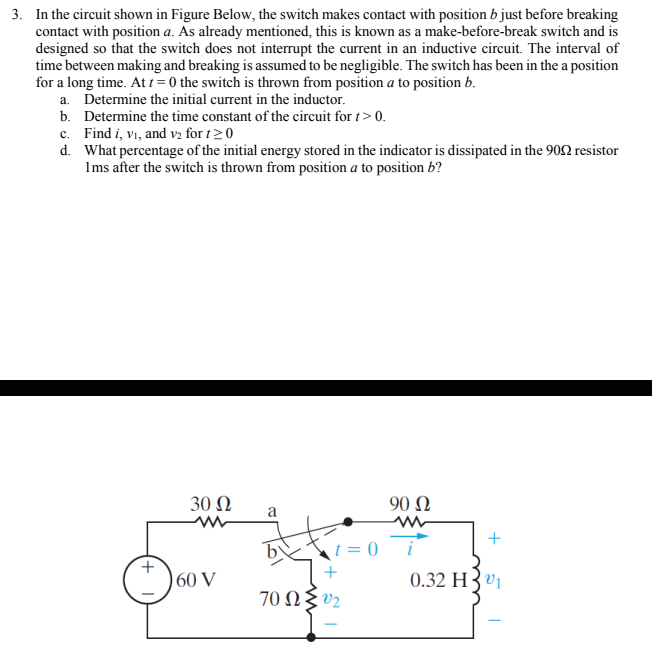3. In the circuit shown in Figure Below, the switch makes contact with position b just before breaking contact with position a. As already mentioned, this is known as a make-before-break switch and is designed so that the switch does not interrupt the current in an inductive circuit. The interval of time between making and breaking is assumed to be negligible. The switch has been in the a position for a long time. At t = 0 the switch is thrown from position a to position b. a. Determine the initial current in the inductor. b. Determine the time constant of the circuit for t> 0. c. Find i, vi, and v2 for t20 d. What percentage of the initial energy stored in the indicator is dissipated in the 902 resistor Ims after the switch is thrown from position a to position b?
3. In the circuit shown in Figure Below, the switch makes contact with position b just before breaking contact with position a. As already mentioned, this is known as a make-before-break switch and is designed so that the switch does not interrupt the current in an inductive circuit. The interval of time between making and breaking is assumed to be negligible. The switch has been in the a position for a long time. At t = 0 the switch is thrown from position a to position b. a. Determine the initial current in the inductor. b. Determine the time constant of the circuit for t> 0. c. Find i, vi, and v2 for t20 d. What percentage of the initial energy stored in the indicator is dissipated in the 902 resistor Ims after the switch is thrown from position a to position b?
Introductory Circuit Analysis (13th Edition)
13th Edition
ISBN:9780133923605
Author:Robert L. Boylestad
Publisher:Robert L. Boylestad
Chapter1: Introduction
Section: Chapter Questions
Problem 1P: Visit your local library (at school or home) and describe the extent to which it provides literature...
Related questions
Question
please answer all because continous question please Tutor

Transcribed Image Text:3. In the circuit shown in Figure Below, the switch makes contact with position b just before breaking
contact with position a. As already mentioned, this is known as a make-before-break switch and is
designed so that the switch does not interrupt the current in an inductive circuit. The interval of
time between making and breaking is assumed to be negligible. The switch has been in the a position
for a long time. At t = 0 the switch is thrown from position a to position b.
a. Determine the initial current in the inductor.
b. Determine the time constant of the circuit for t> 0.
c. Find i, vi, and v2 for t20
d. What percentage of the initial energy stored in the indicator is dissipated in the 902 resistor
Ims after the switch is thrown from position a to position b?
30 Ω
90 Ω
a
t = 0
+
60 V
0.32 H3v1
70 Ωξυ2
Expert Solution
This question has been solved!
Explore an expertly crafted, step-by-step solution for a thorough understanding of key concepts.
This is a popular solution!
Trending now
This is a popular solution!
Step by step
Solved in 3 steps with 3 images

Knowledge Booster
Learn more about
Need a deep-dive on the concept behind this application? Look no further. Learn more about this topic, electrical-engineering and related others by exploring similar questions and additional content below.Recommended textbooks for you

Introductory Circuit Analysis (13th Edition)
Electrical Engineering
ISBN:
9780133923605
Author:
Robert L. Boylestad
Publisher:
PEARSON

Delmar's Standard Textbook Of Electricity
Electrical Engineering
ISBN:
9781337900348
Author:
Stephen L. Herman
Publisher:
Cengage Learning

Programmable Logic Controllers
Electrical Engineering
ISBN:
9780073373843
Author:
Frank D. Petruzella
Publisher:
McGraw-Hill Education

Introductory Circuit Analysis (13th Edition)
Electrical Engineering
ISBN:
9780133923605
Author:
Robert L. Boylestad
Publisher:
PEARSON

Delmar's Standard Textbook Of Electricity
Electrical Engineering
ISBN:
9781337900348
Author:
Stephen L. Herman
Publisher:
Cengage Learning

Programmable Logic Controllers
Electrical Engineering
ISBN:
9780073373843
Author:
Frank D. Petruzella
Publisher:
McGraw-Hill Education

Fundamentals of Electric Circuits
Electrical Engineering
ISBN:
9780078028229
Author:
Charles K Alexander, Matthew Sadiku
Publisher:
McGraw-Hill Education

Electric Circuits. (11th Edition)
Electrical Engineering
ISBN:
9780134746968
Author:
James W. Nilsson, Susan Riedel
Publisher:
PEARSON

Engineering Electromagnetics
Electrical Engineering
ISBN:
9780078028151
Author:
Hayt, William H. (william Hart), Jr, BUCK, John A.
Publisher:
Mcgraw-hill Education,